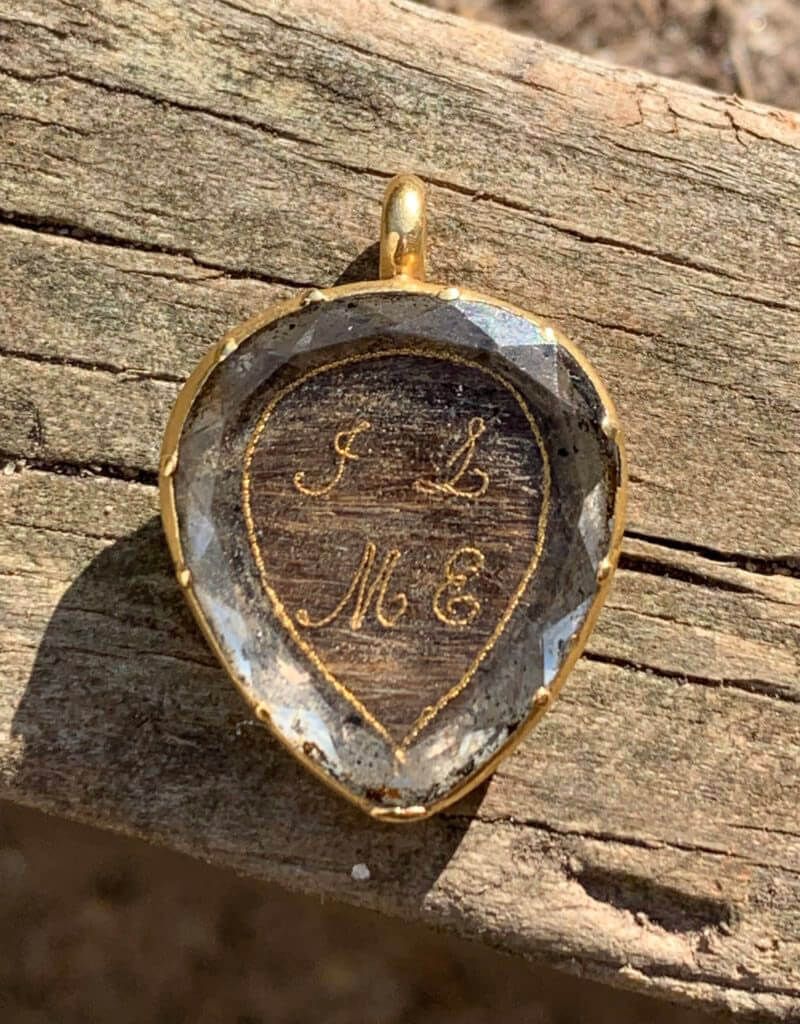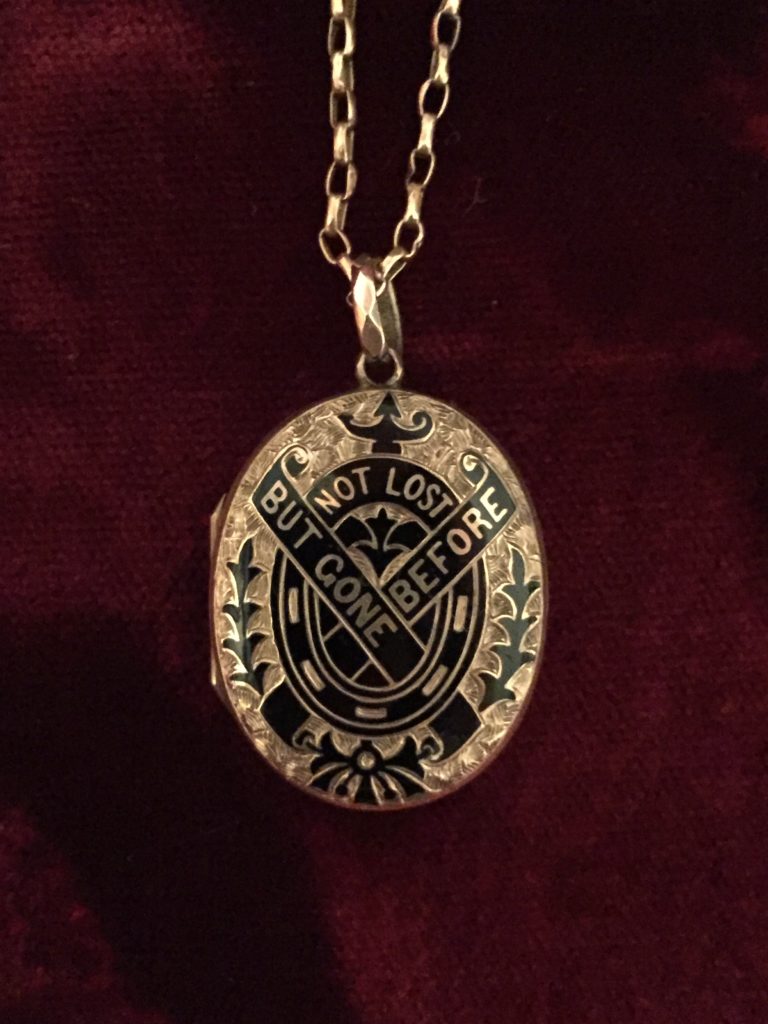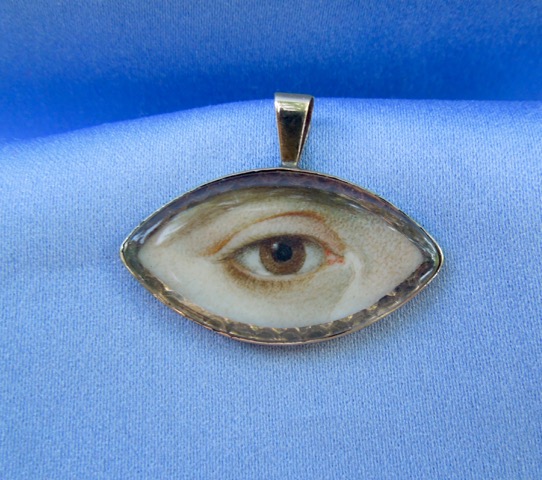Hair Buckle / Garter Pendant
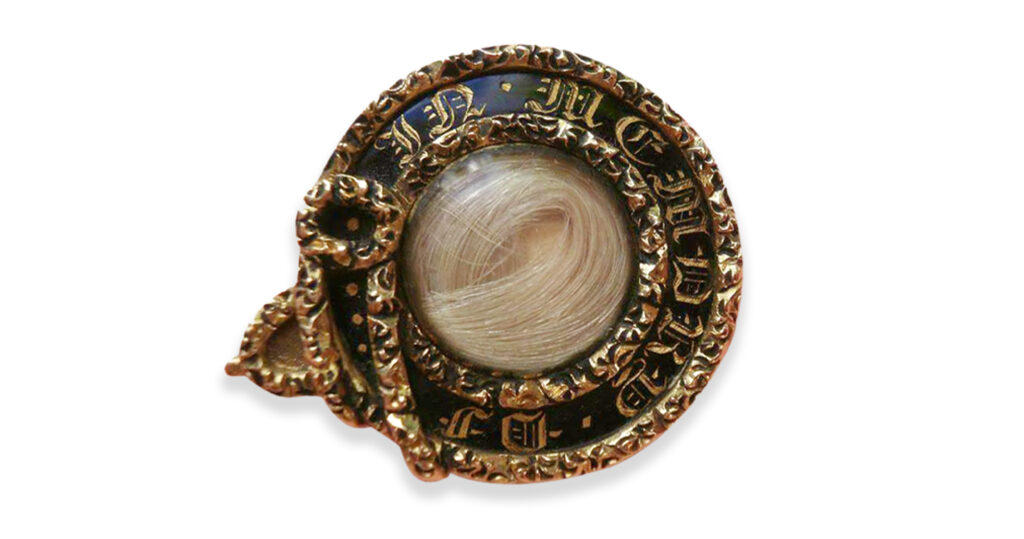
The simplicity and sentimentality of hairwork cannot be understated. It is a material that is intrinsic to only one individual and is not any other’s right to take. When it is given, hair is more precious than any gem, offering a physical piece of someone to another in order for it to remember them by. Any additions to the hair are pleasant, but the sentiment is at its strongest when it is more pure and refined.
Jewels, such as the one featured here, are of the highest sentiment. Its construction is due to the craft of the weaver and the jeweller, combining to create a pendant that has passed through time with its features intact. Because of the nature of the hair being impartial on a religious or social context, styles such as this were popular during the 1800-1820 period across the European continent, though particularly in France.
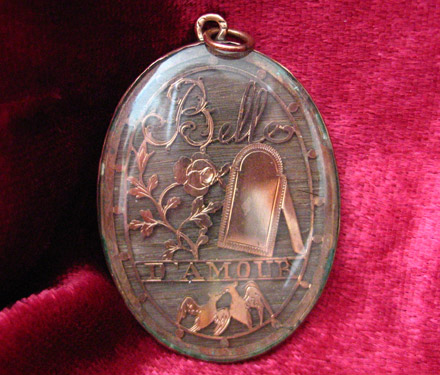
Gumming the hair to weave it across the interior of the front and the back utilises the most from the material, while this piece interestingly uses the garter/buckle motif with woven hair inside the border of the front. The fine gold work that inlays the border is delicately set with pearls that are inlayed into the buckle itself. A copious amount of hair was required to create this jewel, with a suggestion that the colour of the hair was matched to those of professionally purchased hair from the continent. Convents and ladies could grow and sell their hair to weaves around Europe, who had longer and more malleable hair to work with, rather than the locks given by loved ones to jewellers. In this case, it is impossible to tell, however, the quality of the pendant is quite high.
In the 18th century, hair began to take its place as the fashionable sentimental token of affection, enough to substantiate its own industry of hair workers. While not a modern invention of a token of affection, the modern period evolved the giving of hair into commonplace jewellery from the 16th century.

Prior to the rise of the hairworking industry and its prominence in mainstream jewellery, gifts of hair were considered tokens of affection and love between two people. Bury* refers to The Relique (or The Relic) by poet John Donne (1572-1631) and its very early reference to a hair bracelet:
“When my grave is broke up againe
Some second ghest to entertaine,
(For graves have learn’d that woman-head
To be to more than one a Bed)
And he that digs it, spies
A bracelet of bright haire about the bone,
Will he not let us alone,
And thinke that there a loving couple lies”
Donne speaks in metaphysical terms about the unifying nature of spiritual love, as when he and his lover are dug up, they remain the symbol for holy and eternal love. From this, the poem is an excellent perspective on the sentimentality of hairwork at the turn of the 17th century. Wearing hair was an encompassing symbol of union and love between two people.

Donne wasn’t unique in his wearing of a hair bracelet, however, as Count de Grammont, a French nobleman and writer, viewed several people wearing hairwork bracelets in the Court of the restored Charles II, circa 1660. This ties in with the rising prominence of other sentimental jewellery at that time. From love tokens, such as posy rings, to hair woven under crystal in slides, brooches, rings and other forms of jewellery, sentimental jewellery was rapidly evolving over the 17th century. Within these forms of sentimental jewellery, the use of hair became ever more prominent. Another example from 1647/8 of the popularity of hairwork within mainstream culture can be seen in Mary Varney’s letter to Sir Ralph Varney, asking to send locks of their daughter’s hair “to make bracelets? I know you could not send a more acceptable thing than every one of your sisters a bracelet”. At the time, Ralph was living in exile in France during the Protectorate. Hair tokens within families was the more common practice, but as jewels grew as a social device, so did their nature as a personal statement.
“Hair is at once the most delicate and lasting of our materials and survives us like love. It is so light, so gentle, so escaping from the idea of death, that, with a lock of hair belonging to a child or friend, we may almost look to to Heaven and compare notes with angelic nature, may almost say: ‘I have a piece of thee here, not unworthy of thy being now.’ – Godley’s Lady’s Book, 1860
In the Paris Exhibition of 1855, a life-size portrait of Queen Victoria was created, a worthwhile homage to a queen who appreciated the sentiment of hairwork so much. Indeed, with such a cultural importance on the value of hair as a material, the French were the epitome of style and to use such a material in a gesture shows just how widespread hair was used in mainstream fashion.

In 1858, fashion magazine La Belle Assemblè referred to the French hairwork artist Limmonièr in a revolutionary light. La Belle Assemblè expands on the association with hairwork as a sentimental device and identifies it as a jewellery construction material in its own right, not simply “in which some beloved tress or precious curl is entwined”.
Referring back to the jewel of this article and it’s clear to see that the sentiment of it was highly popular for its time. Hair was considered for its art in the 19th century, not as simply just a material to be woven into a jewel. This is important to note, as the pendant of this article has all the characteristics of a fine weave. When a material is favoured over another in a jewel, this is a consideration of the jeweller’s art. Why is it necessarily used prominently? The factor here is that the hair is the pride of the weaver and it resonates with the message of love that the pendant is trying to convey. In the following advertisement for the jeweller Limmonièr, the importance of hair is not understated:
“(Old styles) gave the appearance of having been designed from a ‘mortuary tablet’. Have we not all met ladies wearing as a brooch, by way of loving remembrance, a tomb between two willow trees formed of the hair of the individual from whom their crepe was worn, and which from its very nature must be laid aside with it? But the new hair jewelry made by Limmonièr is an ornament for all times and places. He expands it into a broad ribbon as a bracelet and fastens it with a forget-me-not in turquoise and brilliants; weaves it into chains for the neck, the flacon, or the fan; makes it into a medallion, or leaves and flowers; and of these last the most beautiful specimens I have seen have been formed of the saintly white hair of age. This he converts into orange flowers, white roses, chrysanthemum and most charming of all, clusters of lily-of-the-valley.”
La Belle Assemblè provides a very good advertising spiel for Limmonièr but also provides an insight into how the French perceived hairwork in 1858. By the latter half of the 19th century, hairwork was nearing a phase of unpopularity in France, though this article shows how hairwork was removed, or was attempted to be removed, from mourning and memorials. The article ridicules prior styles of hairwork, as being designed from a “mortuary tablet”, and the stale nature of the depictions of hairwork. By 1858, many of these symbols were not being heavily used in mainstream mourning jewellery, being widely used in the late 18th century / early 19th century with the popularity of neo-classical art. However, the point is made, that hairwork is a beautiful material when combined with Limmonièr’s artistry.
When the context of the jewel is understood, the symbolism needs further study. In this piece, the belt/buckle/garter motif encapsulates the entire pendant. Clearly, the point is symbolic in love, but what are the reasons for it?

Function is at the heart of the belt motif; a function which identifies the importance of necessity in the symbol and one which connects two people through a requirement. The belt/buckle motif ties together two people by symbolically wrapping around and tying itself. It keeps the concept of love secure, regardless of the pressures that may be against it.
In the 19th century, which is where the motif found its greatest prominence, the use of the belt/buckle had developed from Roman style buckles into ornamentation. Adorned designs and ceremonial uses being typical in earlier times until cheaper, moulded, methods of production in the 15th century allowed for general access to the device by the public.
From its constant visibility in jewellery symbolism, many pieces from the 19th century are resonant of The Most Noble Order of the Garter, an order of chivalry founded in 1348. The order is the highest honour that can be bestowed upon a person within the United Kingdom and within the crest, the symbol can be seen encapsulating St George’s Cross with ‘Honi soit qui mal y pense’ (shamed be he who thinks evil of it) written within. This honour is reserved for the Sovereign, Prince of Wales and twenty-four members.
Origins of the garter and sentiment are vague, however all relate to Edward III. At the Battle of Crécy, he said to have given his garter as a signal. Due to its chivalrous nature, it has been suggested that it was a revival of the Round Table or even a way to claim the French throne (shame on those who would oppose the King’s desire for the throne). Another interpretation is that while dancing with Joan of Kent, her garter slipped to her ankle and caused humiliation. Edward placed the garter around his leg in an act of chivalry and the motto was said as a way to chastise anyone who laughed and lacked humility. The year of foundation is said to be 1348, which is the date of identification for when Edward issued the Garter’s vestments.
Much the same way as blue enamel is an identifier for a loved one to be considered royalty, the belt/buckle/garter is a way of bestowing this honour upon a loved one. Chivalry, as a concept which was revived by the Romantic period of the 19th century.
Sometimes it is the simplicity of a symbol or a design that makes it so special. Less is more, rather than following up the word ‘love’ with a quantifier to dilute its meaning, this jewel captures the hair of the loved one and presents its message clearly. It is a testament to the weaver of the jewel and the way it would have been worn that resonate the pride of its meaning.




